599 scholarly books by Russell Sage Foundation and 21
have author last names that start with W
599 scholarly books by Russell Sage Foundation and 21
599 scholarly books by Russell Sage Foundation
21 have author last names that start with W have author last names that start with W
21 have author last names that start with W have author last names that start with W

The Future of Meta-Analysis
Kenneth W. Wachter
Russell Sage Foundation, 1990
Scientific progress often begins with the difficult task of preparing informed, conclusive reviews of existing research. Since the 1970s, the traditional "subjective" approach to research reviewing in the social sciences has been challenged by a statistical alternative known as meta-analysis. Meta-analysis provides a principled method of distilling reliable generalizations from previous studies on a single topic, thereby providing a quantitative and objective background for future research. The Future of Meta-Analysis brings together expert researchers for an in-depth examination of this new methodology—not to promote a consensus view but rather to explore from several perspectives the theories, tensions, and concerns of meta-analysis, and to illustrate through concrete examples the rationale behind meta-analytic decisions. In a meta-analysis prepared especially for this volume, a statistician and a psychologist review the existing literature on aphasia treatment. In a second study, experts analyze six still-unpublished meta-analyses sponsored by the National Institute of Education to investigate the effects of school desegregation on the academic achievement of black children. This unique case study approach provides valuable discussion of the process of meta-analysis and of the current implications of meta-analysis for policy assessment. Prepared under the auspices of the National Research Council, The Future of Meta-Analysis presents a forum for leaders in this rapidly evolving field to discuss salient conceptual and technical issues and to offer a new theoretical framework, further methodological guidance, and statistical innovations that anticipate a future in which meta-analysis will play an even more effective and valuable role in social science research.
[more]

Britain's War on Poverty
Jane Waldfogel
Russell Sage Foundation, 2010
In 1999, one in four British children lived in poverty—the third highest child poverty rate among industrialized countries. Five years later, the child poverty rate in Britain had fallen by more than half in absolute terms. How did the British government accomplish this and what can the United States learn from the British experience? Jane Waldfogel offers a sharp analysis of the New Labour government's anti-poverty agenda, its dramatic early success and eventual stalled progress. Comparing Britain's anti-poverty initiative to U.S. welfare reform, the book shows how the policies of both countries have affected child poverty, living standards, and well-being in low-income families and suggests next steps for future reforms. Britain's War on Poverty evaluates the three-pronged anti-poverty strategy employed by the British government and what these efforts accomplished. British reforms sought to promote work and make work pay, to increase financial support for families with children, and to invest in the health, early-life development, and education of children. The latter two features set the British reforms apart from the work-oriented U.S. welfare reforms, which did not specifically target income or program supports for children. Plagued by premature initiatives and what some experts called an overly ambitious agenda, the British reforms fell short of their intended goal but nevertheless significantly increased single-parent employment, raised incomes for low-income families, and improved child outcomes. Poverty has fallen, and the pattern of low-income family expenditures on child enrichment and healthy food has begun to converge with higher-income families. As Waldfogel sees it, further success in reducing child poverty in Britain will rely on understanding who is poor and who is at highest risk. More than half of poor children live in families where at least one parent is working, followed by unemployed single- and two-parent homes, respectively. Poverty rates are also notably higher for children with disabled parents, large families, and for Pakistani and Bangladeshi children. Based on these demographics, Waldfogel argues that future reforms must, among other goals, raise working-family incomes, provide more work for single parents, and better engage high-risk racial and ethnic minority groups. What can the United States learn from the British example? Britain's War on Poverty is a primer in the triumphs and pitfalls of protracted policy. Notable differences distinguish the British and U.S. models, but Waldfogel asserts that a future U.S. poverty agenda must specifically address child poverty and the income inequality that helps create it. By any measurement and despite obstacles, Britain has significantly reduced child poverty. The book's key lesson is that it can be done.
[more]
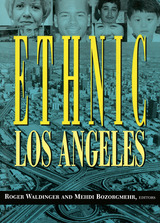
Ethnic Los Angeles
Roger Waldinger
Russell Sage Foundation, 1996
Since 1965 more immigrants have come to Los Angeles than anywhere else in the United States. These newcomers have rapidly and profoundly transformed the city's ethnic makeup and sparked heated debate over their impact on the region's troubled economy. Ethnic Los Angeles presents a multi-investigator study of L.A.'s immigrant population, exploring the scope, characteristics, and consequences of ethnic transition in the nation's second most populous urban center. Using the wealth of information contained in the U.S. censuses of 1970, 1980, and 1990, essays on each of L.A.'s major ethnic groups tell who the immigrants are, where they come from, the skills they bring and their sources of employment, and the nature of their families and social networks. The contributors explain the history of legislation and economic change that made the city a magnet for immigration, and compare the progress of new immigrants to those of previous eras. Recent immigrants to Los Angeles follow no uniform course of adaptation, nor do they simply assimilate into the mainstream society. Instead, they have entered into distinct niches at both the high and low ends of the economic spectrum. While Asians and Middle Easterners have thrived within the medical and technical professions, low-skill newcomers from Central America provide cheap labor in light manufacturing industries. As Ethnic Los Angeles makes clear, the city's future will depend both on how well its economy accommodates its diverse population, and on how that population adapts to economic changes. The more prosperous immigrants arrived already possessed of advanced educations and skills, but what does the future hold for less-skilled newcomers? Will their children be able to advance socially and economically, as the children of previous immigrants once did? The contributors examine the effect of racial discrimination, both in favoring low-skilled immigrant job seekers over African Americans, and in preventing the more successful immigrants and native-born ethnic groups from achieving full economic parity with whites. Ethnic Los Angeles is an illuminating portrait of a city whose unprecedented changes are sure to be replicated in other urban areas as new concentrations of immigrants develop. Backed by detailed demographic information and insightful analyses, this volume engages all of the issues that are central to today's debates about immigration, ethnicity, and economic opportunity in a post-industrial urban society.
[more]

Landscape of Modernity
Essays on New York City, 1900-1940
David Ward
Russell Sage Foundation, 1992
New York City stands as the first expression of the modern city, a mosaic of disparate neighborhoods born in 1898 with the amalgamation of the five boroughs and shaped by the passions of developers and regulators, architects and engineers, politicians and reformers, immigrant entrepreneurs and corporate builders. Through their labor, their ideals, and their often fierce battles, the physical and social dimensions—the landscape—of the modern city were forged. The original essays in The Landscape of Modernity tell the compelling story of the growth of New York City from 1900 to 1940, from the beginnings of its skyscraper skyline to the expanding reaches of suburbanization. At the beginning of the century, New York City was already one of the world's leading corporate and commercial centers. The Zoning Ordinance of 1916, initially proposed by Fifth Avenue merchants as a means of halting the uptown spread of the garment industry, became the nation's first comprehensive zoning law and the proving ground for a new occupation—the urban planner. During the 1920s, frenzied development created a vertical metamorphosis in Manhattan's booming business district, culminating in its most spectacularly modern icon, the Empire State Building. The city also spread laterally, with the controversial development of subway systems and the creation of the powerful Port of New York Authority, whose new bridges and tunnels decentralized the population and industry of New York. New York's older ethnic enclaves were irrevocably altered by this new urban landscape: the Lower East Side's Jewish community was nearly dismantled by the flight of the garment industry and the attractiveness of new suburbs, while Little Italy fought government forces eager to homogenize commercial use of the streets by eliminating the traditional pushcart peddlers. Illustrated with striking photographs and maps, The Landscape of Modernity links important scenes of growth and development to the larger political, economic, social, and cultural processes of the early twentieth century.
[more]
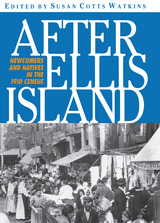
After Ellis Island
Newcomers and Natives in the 1910 Census
Susan Cotts Watkins
Russell Sage Foundation, 1994
After Ellis Island is an unprecedented study of America's foreign-born population at a critical juncture in immigration history. The new century had witnessed a tremendous surge in European immigration, and by 1910 immigrants and their children numbered nearly one third of the U.S. population. The census of that year drew from these newcomers a particularly rich trove of descriptive information, one from which the contributors to After Ellis Island draw to create an unmatched profile of American society in transition. Chapters written especially for this volume explore many aspects of the immigrants' lives, such as where they settled, the jobs they held, how long they remained in school, and whether or not they learned to speak English. More than a demographic catalog, After Ellis Island employs a wide range of comparisons among ethnic groups to probe whether differences in childbirth, child mortality, and education could be traced to cultural or environmental causes. Did differences in schooling levels diminish among groups in the same social and economic circumstances, or did they persist along ethnic lines? Did absorption into mainstream America—measured through duration of U.S. residence, neighborhood mingling, and ability to speak English—blur ethnic differences and increase chances for success? After Ellis Island also shows how immigrants eased the nation's transition from agriculture to manufacturing by providing essential industrial laborers. After Ellis Island offers a major assessment of ethnic diversity in early twentieth century American society. The questions it addresses about assimilation and employment among immigrants in 1910 acquire even greater significance as we observe a renewed surge of foreign arrivals. This volume will be valuable to sociologists and historians of immigration, to demographers and economists, and to all those interested in the relationship of ethnicity to opportunity.
[more]
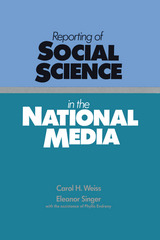
Reporting of Social Science in the National Media
Carol Weiss
Russell Sage Foundation, 1988
Policy makers, as well as the general public, are often unaware of social science research until a story about it appears in the national media. Even in official Washington, a staffer's report on social research may go unnoticed while a report in the Washington Post receives immediate attention. This study takes a systematic and revealing look at social science reporting. How do journalists hear about social science, and why do they select certain stories to cover and not others? How do journalistic standards for selection compare with social scientists' own judgments of merit? How do reporters attempt to ensure accuracy, and how freely do they introduce their own interpretations of social science findings? How satisfied are social scientists with the selection and accuracy of social science news? In Part I, Carol H. Weiss addresses these questions on the basis of personal interviews with social scientists and the journalists who wrote about their work. Part II, by Eleanor Singer, is based on an analysis of media content itself, and compares social science reporting over time (between 1970 and 1982) and across media (newspapers, newsmagazines, television). These two complementary perspectives combine to produce a thorough, realistic assessment of the way social science moves out of the academy and into the world of news.
[more]

Low-Wage Work in Denmark
Niels Westergaard-Nielsen
Russell Sage Foundation, 2008
The Danish economy offers a dose of American labor market flexibility inside a European welfare state. The Danish government allows employers a relatively high level of freedom to dismiss workers, but also provides generous unemployment insurance. Widespread union coverage and an active system of collective bargaining help regulate working conditions in the absence of strong government regulation. Denmark's rate of low-wage work—8.5 percent—is the lowest of the five countries under analysis. In Low-Wage Work in Denmark, a team of Danish researchers combines comprehensive national registry data with detailed case studies of five industries to explore why low-end jobs are so different in Denmark. Some jobs that are low-paying in the United States, including hotel maids and meat processors, though still demanding, are much more highly compensated in Denmark. And Danes, unlike American workers, do not stay in low-wage jobs for long. Many go on to higher paying jobs, while a significant minority ends up relying temporarily on income support and benefits sustained by one of the highest tax rates in the world. Low-Wage Work in Denmark provides an insightful look at the particularities of the Danish labor market and the lessons it holds for both the United States and the rest of Europe. A Volume in the Russell Sage Foundation Case Studies of Job Quality in Advanced Economies
[more]

Homeward
Life in the Year After Prison
Bruce Western
Russell Sage Foundation, 2018
In the era of mass incarceration, over 600,000 people are released from federal or state prison each year, with many returning to chaotic living environments rife with violence. In these circumstances, how do former prisoners navigate reentering society? In Homeward, sociologist Bruce Western examines the tumultuous first year after release from prison. Drawing from in-depth interviews with over one hundred individuals, he describes the lives of the formerly incarcerated and demonstrates how poverty, racial inequality, and failures of social support trap many in a cycle of vulnerability despite their efforts to rejoin society.
Western and his research team conducted comprehensive interviews with men and women released from the Massachusetts state prison system who returned to neighborhoods around Boston. Western finds that for most, leaving prison is associated with acute material hardship. In the first year after prison, most respondents could not afford their own housing and relied on family support and government programs, with half living in deep poverty. Many struggled with chronic pain, mental illnesses, or addiction—the most important predictor of recidivism. Most respondents were also unemployed. Some older white men found union jobs in the construction industry through their social networks, but many others, particularly those who were black or Latino, were unable to obtain full-time work due to few social connections to good jobs, discrimination, and lack of credentials. Violence was common in their lives, and often preceded their incarceration. In contrast to the stereotype of tough criminals preying upon helpless citizens, Western shows that many former prisoners were themselves subject to lifetimes of violence and abuse and encountered more violence after leaving prison, blurring the line between victims and perpetrators.
Western concludes that boosting the social integration of former prisoners is key to both ameliorating deep disadvantage and strengthening public safety. He advocates policies that increase assistance to those in their first year after prison, including guaranteed housing and health care, drug treatment, and transitional employment. By foregrounding the stories of people struggling against the odds to exit the criminal justice system, Homeward shows how overhauling the process of prisoner reentry and rethinking the foundations of justice policy could address the harms of mass incarceration.
Western and his research team conducted comprehensive interviews with men and women released from the Massachusetts state prison system who returned to neighborhoods around Boston. Western finds that for most, leaving prison is associated with acute material hardship. In the first year after prison, most respondents could not afford their own housing and relied on family support and government programs, with half living in deep poverty. Many struggled with chronic pain, mental illnesses, or addiction—the most important predictor of recidivism. Most respondents were also unemployed. Some older white men found union jobs in the construction industry through their social networks, but many others, particularly those who were black or Latino, were unable to obtain full-time work due to few social connections to good jobs, discrimination, and lack of credentials. Violence was common in their lives, and often preceded their incarceration. In contrast to the stereotype of tough criminals preying upon helpless citizens, Western shows that many former prisoners were themselves subject to lifetimes of violence and abuse and encountered more violence after leaving prison, blurring the line between victims and perpetrators.
Western concludes that boosting the social integration of former prisoners is key to both ameliorating deep disadvantage and strengthening public safety. He advocates policies that increase assistance to those in their first year after prison, including guaranteed housing and health care, drug treatment, and transitional employment. By foregrounding the stories of people struggling against the odds to exit the criminal justice system, Homeward shows how overhauling the process of prisoner reentry and rethinking the foundations of justice policy could address the harms of mass incarceration.
[more]
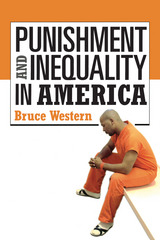
Punishment and Inequality in America
Bruce Western
Russell Sage Foundation, 2006
Over the last thirty years, the prison population in the United States has increased more than seven-fold to over two million people, including vastly disproportionate numbers of minorities and people with little education. For some racial and educational groups, incarceration has become a depressingly regular experience, and prison culture and influence pervade their communities. Almost 60 percent of black male high school drop-outs in their early thirties have spent time in prison. In Punishment and Inequality in America, sociologist Bruce Western explores the recent era of mass incarceration and the serious social and economic consequences it has wrought. Punishment and Inequality in America dispels many of the myths about the relationships among crime, imprisonment, and inequality. While many people support the increase in incarceration because of recent reductions in crime, Western shows that the decrease in crime rates in the 1990s was mostly fueled by growth in city police forces and the pacification of the drug trade. Getting "tough on crime" with longer sentences only explains about 10 percent of the fall in crime, but has come at a significant cost. Punishment and Inequality in America reveals a strong relationship between incarceration and severely dampened economic prospects for former inmates. Western finds that because of their involvement in the penal system, young black men hardly benefited from the economic boom of the 1990s. Those who spent time in prison had much lower wages and employment rates than did similar men without criminal records. The losses from mass incarceration spread to the social sphere as well, leaving one out of ten young black children with a father behind bars by the end of the 1990s, thereby helping perpetuate the damaging cycle of broken families, poverty, and crime. The recent explosion of imprisonment is exacting heavy costs on American society and exacerbating inequality. Whereas college or the military were once the formative institutions in young men's lives, prison has increasingly usurped that role in many communities. Punishment and Inequality in America profiles how the growth in incarceration came about and the toll it is taking on the social and economic fabric of many American communities.
[more]

On Record
Files and Dossiers in American Life
Stanton Wheeler
Russell Sage Foundation, 1970
On Record provides descriptive accounts of record keeping in a variety of important organizations: schools, from elementary to graduate school; consumer credit agencies, general business organizations, and life insurance companies; the military and security agencies; the Census Bureau and the Social Security Administration; public welfare agencies, juvenile courts, and mental hospitals. It also examines the legal status of records. The authors pose questions such as the following: Who determines what records are kept? Who has access to the records?
[more]

Credit Where It's Due
Rethinking Financial Citizenship
Frederick F. Wherry
Russell Sage Foundation, 2019
An estimated 45 million adults in the U.S. lack a credit score at time when credit invisibility can reduce one’s ability to rent a home, find employment, or secure a mortgage or loan. As a result, individuals without credit—who are disproportionately African American and Latino—often lead separate and unequal financial lives. Yet, as sociologists and public policy experts Frederick Wherry, Kristin Seefeldt, and Anthony Alvarez argue, many people who are not recognized within the financial system engage in behaviors that indicate their credit worthiness. How might institutions acknowledge these practices and help these people emerge from the financial shadows? In Credit Where It’s Due, the authors evaluate an innovative model of credit-building and advocate for a new understanding of financial citizenship, or participation in a financial system that fosters social belonging, dignity, and respect.
Wherry, Seefeldt, and Alvarez tell the story of the Mission Asset Fund, a San Francisco-based organization that assists mostly low- and moderate-income people of color with building credit. The Mission Asset Fund facilitates zero-interest lending circles, which have been practiced by generations of immigrants, but have gone largely unrecognized by mainstream financial institutions. Participants decide how the circles are run and how they will use their loans, and the organization reports their clients’ lending activity to credit bureaus. As the authors show, this system not only helps clients build credit, but also allows them to manage debt with dignity, have some say in the creation of financial products, and reaffirm their sense of social membership. The authors delve into the history of racial wealth inequality in the U.S. to show that for many black and Latino households, credit invisibility is not simply a matter of individual choices or inadequate financial education. Rather, financial marginalization is the result of historical policies that enabled predatory lending, discriminatory banking and housing practices, and the rollback of regulatory protections for first-time homeowners.
To rectify these inequalities, the authors propose common sense regulations to protect consumers from abuse alongside new initiatives that provide seed capital for every child, create affordable short-term loans, and ensure that financial institutions treat low- and moderate-income clients with equal respect. By situating the successes of the Mission Asset Fund in the larger history of credit and debt, Credit Where It’s Due shows how to prioritize financial citizenship for all.
Wherry, Seefeldt, and Alvarez tell the story of the Mission Asset Fund, a San Francisco-based organization that assists mostly low- and moderate-income people of color with building credit. The Mission Asset Fund facilitates zero-interest lending circles, which have been practiced by generations of immigrants, but have gone largely unrecognized by mainstream financial institutions. Participants decide how the circles are run and how they will use their loans, and the organization reports their clients’ lending activity to credit bureaus. As the authors show, this system not only helps clients build credit, but also allows them to manage debt with dignity, have some say in the creation of financial products, and reaffirm their sense of social membership. The authors delve into the history of racial wealth inequality in the U.S. to show that for many black and Latino households, credit invisibility is not simply a matter of individual choices or inadequate financial education. Rather, financial marginalization is the result of historical policies that enabled predatory lending, discriminatory banking and housing practices, and the rollback of regulatory protections for first-time homeowners.
To rectify these inequalities, the authors propose common sense regulations to protect consumers from abuse alongside new initiatives that provide seed capital for every child, create affordable short-term loans, and ensure that financial institutions treat low- and moderate-income clients with equal respect. By situating the successes of the Mission Asset Fund in the larger history of credit and debt, Credit Where It’s Due shows how to prioritize financial citizenship for all.
[more]
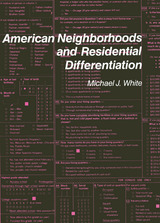
American Neighborhoods and Residential Differentiation
Michael J. White
Russell Sage Foundation, 1987
Residential patterns are reflections of social structure; to ask, "who lives in which neighborhoods," is to explore a sorting-out process that is based largely on socioeconomic status, ethnicity, and life cycle characteristics. This benchmark volume uses census data, with its uniquely detailed information on small geographic areas, to bring into focus the familiar yet often vague concept of neighborhood. Michael White examines nearly 6,000 census tracts (approximating neighborhoods) in twenty-one representative metropolitan areas, from Atlanta to Salt Lake City, Newark to San Diego. The availability of statistics spanning several decades and covering a wide range of demographic characteristics (including age, race, occupation, income, and housing quality) makes possible a rich analysis of the evolution and implications of differences among neighborhoods. In this complex mosaic, White finds patterns and traces them over time—showing, for example, how racial segregation has declined modestly while socioeconomic segregation remains constant, and how population diffusion gradually affects neighborhood composition. His assessment of our urban settlement system also illuminates the social forces that shape contemporary city life and the troubling policy issues that plague it. A Volume in the Russell Sage Foundation Census Series
[more]

Achieving Anew
How New Immigrants Do in American Schools, Jobs, and Neighborhoods
Michael J. White
Russell Sage Foundation, 2009
Can the recent influx of immigrants successfully enter the mainstream of American life, or will many of them fail to thrive and become part of a permanent underclass? Achieving Anew examines immigrant life in school, at work, and in communities and demonstrates that recent immigrants and their children do make substantial progress over time, both within and between generations. From policymakers to private citizens, our national conversation on immigration has consistently questioned the country's ability to absorb increasing numbers of foreign nationals—now nearly one million legal entrants per year. Using census data, longitudinal education surveys, and other data, Michael White and Jennifer Glick place their study of new immigrant achievement within a context of recent developments in assimilation theory and policies regulating who gets in and what happens to them upon arrival. They find that immigrant status itself is not an important predictor of educational achievement. First-generation immigrants arrive in the United States with less education than native-born Americans, but by the second and third generation, the children of immigrants are just as successful in school as native-born students with equivalent social and economic background. As with prior studies, the effects of socioeconomic background and family structure show through strongly. On education attainment, race and ethnicity have a strong impact on achievement initially, but less over time. Looking at the labor force, White and Glick find no evidence to confirm the often-voiced worry that recent immigrants and their children are falling behind earlier arrivals. On the contrary, immigrants of more recent vintage tend to catch up to the occupational status of natives more quickly than in the past. Family background, educational preparation, and race/ethnicity all play a role in labor market success, just as they do for the native born, but the offspring of immigrants suffer no disadvantage due to their immigrant origins. New immigrants continue to live in segregated neighborhoods, though with less prevalence than native black-white segregation. Immigrants who arrived in the 1960s are now much less segregated than recent arrivals. Indeed, the authors find that residential segregation declines both within and across generations. Yet black and Mexican immigrants are more segregated from whites than other groups, showing that race and economic status still remain powerful influences on where immigrants live. Although the picture is mixed and the continuing significance of racial factors remains a concern, Achieving Anew provides compelling reassurance that the recent wave of immigrants is making impressive progress in joining the American mainstream. The process of assimilation is not broken, the advent of a new underclass is not imminent, and the efforts to argue for the restriction of immigration based on these fears are largely mistaken.
[more]
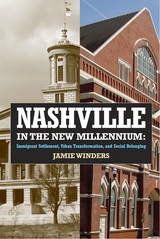
Nashville in the New Millennium
Immigrant Settlement, Urban Transformation, and Social Belonging
Jamie Winders
Russell Sage Foundation, 2013
Beginning in the 1990s, the geography of Latino migration to and within the United States started to shift. Immigrants from Central and South America increasingly bypassed the traditional gateway cities to settle in small cities, towns, and rural areas throughout the nation, particularly in the South. One popular new destination—Nashville, Tennessee—saw its Hispanic population increase by over 400 percent between 1990 and 2000. Nashville, like many other such new immigrant destinations, had little to no history of incorporating immigrants into local life. How did Nashville, as a city and society, respond to immigrant settlement? How did Latino immigrants come to understand their place in Nashville in the midst of this remarkable demographic change? In Nashville in the New Millennium, geographer Jamie Winders offers one of the first extended studies of the cultural, racial, and institutional politics of immigrant incorporation in a new urban destination. Moving from schools to neighborhoods to Nashville’s wider civic institutions, Nashville in the New Millennium details how Nashville’s long-term residents and its new immigrants experienced daily life as it transformed into a multicultural city with a new cosmopolitanism. Using an impressive array of methods, including archival work, interviews, and participant observation, Winders offers a fine-grained analysis of the importance of historical context, collective memories and shared social spaces in the process of immigrant incorporation. Lacking a shared memory of immigrant settlement, Nashville’s long-term residents turned to local history to explain and interpret a new Latino presence. A site where Latino day laborers gathered, for example, became a flashpoint in Nashville’s politics of immigration in part because the area had once been a popular gathering place for area teenagers in the 1960s and 1970s. Teachers also drew from local historical memories, particularly the busing era, to make sense of their newly multicultural student body. They struggled, however, to help immigrant students relate to the region’s complicated racial past, especially during history lessons on the Jim Crow era and the Civil Rights movement. When Winders turns to life in Nashville’s neighborhoods, she finds that many Latino immigrants opted to be quiet in public, partly in response to negative stereotypes of Hispanics across Nashville. Long-term residents, however, viewed this silence as evidence of a failure to adapt to local norms of being neighborly. Filled with voices from both long-term residents and Latino immigrants, Nashville in the New Millennium offers an intimate portrait of the changing geography of immigrant settlement in America. It provides a comprehensive picture of Latino migration’s impact on race relations in the country and is an especially valuable contribution to the study of race and ethnicity in the South.
[more]
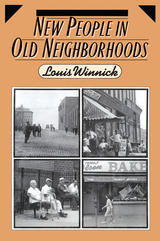
New People in Old Neighborhoods
The Role of Immigrants in Rejuvenating New York's Communities
Louis Winnick
Russell Sage Foundation, 1990
The recent wave of immigration into this country has given rise to myriad concerns—from the worries about the impact of immigration on the nation's economy to questions about whether multilingual education should be used in public schools. The resulting debates have overshadowed some very good news: this influx of New Immigrants has resulted in an astonishing rebirth of many of our older, decaying cities. Nowhere has this demographic renewal been more apparent than in New York City, as Louis Winnick demonstrates in New People in Old Neighborhoods, a timely and perceptive study of the effects of immigration in Brooklyn's Sunset Park. Sunset Park was born of the late nineteenth century flood of immigrants who developed a prosperous waterfront commerce; by the end of World War I the community had achieved a thriving maturity. Yet the decades following World War II brought about a period of urban decay lifted only by the post-1965 influx of more than 20,000 immigrants, most notably from Asia and the Caribbean Basin. These New Immigrants not only revived the dying community but enriched it with greater ethnic diversity than it had ever known. Winnick combines data on ethnic change and living patterns with data on employment, housing, school enrollment, and subway ridership to study the revitalization of Sunset Park. He discusses the ethnic composition and characteristics of the new immigrants; trends in self-employment and entrepreneurship ("microcapitalism"); immigrant impact upon retailing, manufacturing, and the lower echelons of the service industries; skill and education levels; and presence in the professions. Winnick also discusses the immigrants' positive effect on faltering New York systems, such as the subways and public schools, and places immigrant renewal within the larger context of overall housing and economic regeneration in New York City. New People in Old Neighborhoods views today's immigrants as the historic heirs to the community builders of the last century, and offers important insights into the often-troubled yet transforming relationship between the nation and its foreign-born population. The future of these immigrants will be a yardstick to measure the quality and performance of our cities and their neighborhoods in the years ahead.
[more]
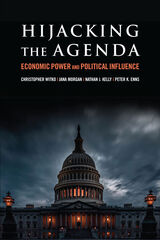
Hijacking the Agenda
Economic Power and Political Influence
Christopher Witko
Russell Sage Foundation, 2021
Why are the economic interests and priorities of lower- and middle-class Americans so often ignored by the U.S. Congress, while the economic interests of the wealthiest are prioritized, often resulting in policies favorable to their interests? In Hijacking the Agenda, political scientists Christopher Witko, Jana Morgan, Nathan J. Kelly, and Peter K. Enns examine why Congress privileges the concerns of businesses and the wealthy over those of average Americans. They go beyond demonstrating that such economic bias exists to illuminate precisely how and why economic policy is so often skewed in favor of the rich.
The authors analyze over 20 years of floor speeches by several hundred members of Congress to examine the influence of campaign contributions on how the national economic agenda is set in Congress. They find that legislators who received more money from business and professional associations were more likely to discuss the deficit and other upper-class priorities, while those who received more money from unions were more likely to discuss issues important to lower- and middle-class constituents, such as economic inequality and wages. This attention imbalance matters because issues discussed in Congress receive more direct legislative action, such as bill introductions and committee hearings. While unions use campaign contributions to push back against wealthy interests, spending by the wealthy dwarfs that of unions.
The authors use case studies analyzing financial regulation and the minimum wage to demonstrate how the financial influence of the wealthy enables them to advance their economic agenda. In each case, the authors examine the balance of structural power, or the power that comes from a person or company’s position in the economy, and kinetic power, the power that comes from the ability to mobilize organizational and financial resources in the policy process. The authors show how big business uses its structural power and resources to effect policy change in Congress, as when the financial industry sought deregulation in the late 1990s, resulting in the passage of a bill eviscerating New Deal financial regulations. Likewise, when business interests want to preserve the policy status quo, it uses its power to keep issues off of the agenda, as when inflation eats into the minimum wage and its declining purchasing power leaves low-wage workers in poverty. Although groups representing lower- and middle-class interests, particularly unions, can use their resources to shape policy responses if conditions are right, they lack structural power and suffer significant resource disadvantages. As a result, wealthy interests have the upper hand in shaping the policy process, simply due to their pivotal position in the economy and the resulting perception that policies beneficial to business are beneficial for everyone.
Hijacking the Agenda is an illuminating account of the way economic power operates through the congressional agenda and policy process to privilege the interests of the wealthy and marks a major step forward in our understanding of the politics of inequality.
The authors analyze over 20 years of floor speeches by several hundred members of Congress to examine the influence of campaign contributions on how the national economic agenda is set in Congress. They find that legislators who received more money from business and professional associations were more likely to discuss the deficit and other upper-class priorities, while those who received more money from unions were more likely to discuss issues important to lower- and middle-class constituents, such as economic inequality and wages. This attention imbalance matters because issues discussed in Congress receive more direct legislative action, such as bill introductions and committee hearings. While unions use campaign contributions to push back against wealthy interests, spending by the wealthy dwarfs that of unions.
The authors use case studies analyzing financial regulation and the minimum wage to demonstrate how the financial influence of the wealthy enables them to advance their economic agenda. In each case, the authors examine the balance of structural power, or the power that comes from a person or company’s position in the economy, and kinetic power, the power that comes from the ability to mobilize organizational and financial resources in the policy process. The authors show how big business uses its structural power and resources to effect policy change in Congress, as when the financial industry sought deregulation in the late 1990s, resulting in the passage of a bill eviscerating New Deal financial regulations. Likewise, when business interests want to preserve the policy status quo, it uses its power to keep issues off of the agenda, as when inflation eats into the minimum wage and its declining purchasing power leaves low-wage workers in poverty. Although groups representing lower- and middle-class interests, particularly unions, can use their resources to shape policy responses if conditions are right, they lack structural power and suffer significant resource disadvantages. As a result, wealthy interests have the upper hand in shaping the policy process, simply due to their pivotal position in the economy and the resulting perception that policies beneficial to business are beneficial for everyone.
Hijacking the Agenda is an illuminating account of the way economic power operates through the congressional agenda and policy process to privilege the interests of the wealthy and marks a major step forward in our understanding of the politics of inequality.
[more]
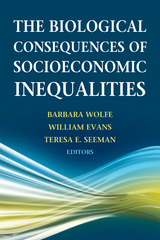
The Biological Consequences of Socioeconomic Inequalities
Barbara Wolfe
Russell Sage Foundation, 2013
Social scientists have repeatedly uncovered a disturbing feature of economic inequality: people with larger incomes and better education tend to lead longer, healthier lives. This pattern holds across all ages and for virtually all measures of health, apparently indicating a biological dimension of inequality. But scholars have only begun to understand the complex mechanisms that drive this disparity. How exactly do financial well-being and human physiology interact? The Biological Consequences of Socioeconomic Inequalities incorporates insights from the social and biological sciences to quantify the biology of disadvantage and to assess how poverty gets under the skin to impact health. Drawing from unusually rich datasets of biomarkers, brain scans, and socioeconomic measures, Biological Consequences of Socioeconomic Inequalities illustrates exciting new paths to understanding social inequalities in health. Barbara Wolfe, William N. Evans and Nancy Adler begin the volume with a critical evaluation of the literature on income and health, providing a lucid review of the difficulties of establishing clear causal pathways between the two variables. In their chapter, Arun S. Karlamangla, Tara L. Gruenewald, and Teresa E. Seeman outline the potential of biomarkers—such as cholesterol, heart pressure, and C-reactive protein—to assess and indicate the factors underlying health. Edith Chen, Hannah M. C. Schreier, and Meanne Chan reveal the empirical power of biomarkers by examining asthma, a condition steeply correlated with socioeconomic status. Their analysis shows how stress at the individual, family, and neighborhood levels can increase the incidence of asthma. The volume then turns to cognitive neuroscience, using biomarkers in a new way to examine the impact of poverty on brain development. Jamie Hanson, Nicole Hair, Amitabh Chandra, Ed Moss, Jay Bhattacharya, Seth D. Pollack, and Barbara Wolfe use a longitudinal Magnetic Resonance Imaging (MRI) study of children between the ages of four and eighteen to study the link between poverty and limited cognition among children. Michelle C. Carlson, Christopher L. Seplaki, and Teresa E. Seeman also focus on brain development to examine the role of socioeconomic status in cognitive decline among older adults. Featuring insights from the biological and social sciences, Biological Consequences of Socioeconomic Inequalities will be an essential resource for scholars interested in socioeconomic disparities and the biological imprint that material deprivation leaves on the human body.
[more]
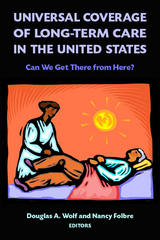
Universal Coverage of Long-Term Care in the United States
Can We Get There from Here?
Douglas A. Wolfe
Russell Sage Foundation, 2013
As millions of baby boomers retire and age in the coming years, more American families will confront difficult choices about the long-term care of their loved ones. The swelling ranks of the disabled and elderly who need such care—including home care, adult day care, or a nursing home stay—are faced with a strained, inequitable and expensive system. How will American society and policy adapt to this demographic transition? In Universal Coverage of Long-Term Care in the United States, editors Nancy Folbre and Douglas Wolf and an expert group of care researchers assess the current U.S. long-term care policies and exercise what can be learned from other countries facing similar care demands. After the high-profile suspension of the Obama Administration’s public long-term insurance program in 2011, Robert Hudson and Howard Gleckman provide concrete suggestions for lowering the cost and improving the quality of long-term care coverage in America. In a deeply personal and empirically rigorous analysis, family care expert Carol Levine draws crucial lessons from her experience as a caregiver for her ailing husband. She sheds light on the often fraught interactions that occur between the formal care system and family caregivers and analyzes how public policy can best support long-term family care. The volume next examines recent reforms in other developed countries and finds valuable lessons for American policy-makers. Contributors David Bell and Alison Bowes discuss the provision of personal care services in Scotland, which have been publicly financed since 2002. Their analysis shows that the new program reduced costs improved efficiency and allowed more recipients to receive care. The volume assesses the political and institutional prospects for moving towards a truly universal long-term care system in the United States. Robyn Stone provides a sobering overview of the formal, paid long-term care workforce in America, which is in crisis due to increasing demand and a shortage of qualified workers. Economist Leonard Burman focuses on public finances of the long-term care system, which will come under increasing strain as more Americans rely on Medicaid to pay for their long-term care. In the volume’s concluding chapter, Folbre and Wolf summarize criticisms of existing long-term care policies and outline particular reforms that can move the United States toward a universal system of long-term care insurance. Universal Coverage of Long-Term Care in the United States provides an essential resource on how to improve the long-term care sector in America and helps advance the national debate on this pressing topic. This volume is available for free download on the Foundation’s website, as are the volume’s individual chapters.
[more]
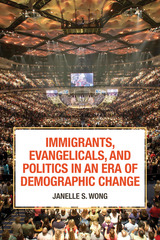
Immigrants, Evangelicals, and Politics in an Era of Demographic Change
Janelle S. Wong
Russell Sage Foundation, 2018
As immigration from Asia and Latin America reshapes the demographic composition of the U.S., some analysts have anticipated the decline of conservative white evangelicals’ influence in politics. Yet, Donald Trump captured a larger share of the white evangelical vote in the 2016 election than any candidate in the previous four presidential elections. Why has the political clout of white evangelicals persisted at a time of increased racial and ethnic diversity? In Immigrants, Evangelicals, and Politics in an Era of Demographic Change, political scientist Janelle Wong examines a new generation of Asian American and Latino evangelicals and offers an account of why demographic change has not contributed to a political realignment.
Asian Americans and Latinos currently constitute 13 percent of evangelicals, and their churches are among the largest, fastest growing organizations in their communities. While evangelical identity is associated with conservative politics, Wong draws from national surveys and interviews to show that non-white evangelicals express political attitudes that are significantly less conservative than those of their white counterparts. Black, Asian American, and Latino evangelicals are much more likely to support policies such as expanded immigration rights, increased taxation of the wealthy, and government interventions to slow climate change. As Wong argues, non-white evangelicals’ experiences as members of racial or ethnic minority groups often lead them to adopt more progressive political views compared to their white counterparts.
However, despite their growth in numbers, non-white evangelicals—particularly Asian Americans and Latinos—are concentrated outside of swing states, have lower levels of political participation than white evangelicals, and are less likely to be targeted by political campaigns. As a result, white evangelicals dominate the evangelical policy agenda and are overrepresented at the polls. Also, many white evangelicals have adopted even more conservative political views in response to rapid demographic change, perceiving, for example, that discrimination against Christians now rivals discrimination against racial and ethnic minorities.
Wong demonstrates that immigrant evangelicals are neither “natural” Republicans nor “natural” Democrats. By examining the changing demographics of the evangelical movement, Immigrants, Evangelicals, and Politics in an Era of Demographic Change sheds light on an understudied constituency that has yet to find its political home.
Asian Americans and Latinos currently constitute 13 percent of evangelicals, and their churches are among the largest, fastest growing organizations in their communities. While evangelical identity is associated with conservative politics, Wong draws from national surveys and interviews to show that non-white evangelicals express political attitudes that are significantly less conservative than those of their white counterparts. Black, Asian American, and Latino evangelicals are much more likely to support policies such as expanded immigration rights, increased taxation of the wealthy, and government interventions to slow climate change. As Wong argues, non-white evangelicals’ experiences as members of racial or ethnic minority groups often lead them to adopt more progressive political views compared to their white counterparts.
However, despite their growth in numbers, non-white evangelicals—particularly Asian Americans and Latinos—are concentrated outside of swing states, have lower levels of political participation than white evangelicals, and are less likely to be targeted by political campaigns. As a result, white evangelicals dominate the evangelical policy agenda and are overrepresented at the polls. Also, many white evangelicals have adopted even more conservative political views in response to rapid demographic change, perceiving, for example, that discrimination against Christians now rivals discrimination against racial and ethnic minorities.
Wong demonstrates that immigrant evangelicals are neither “natural” Republicans nor “natural” Democrats. By examining the changing demographics of the evangelical movement, Immigrants, Evangelicals, and Politics in an Era of Demographic Change sheds light on an understudied constituency that has yet to find its political home.
[more]
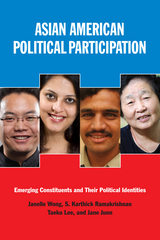
Asian American Political Participation
Emerging Constituents and Their Political Identities
Janelle S. Wong
Russell Sage Foundation, 2012
Asian Americans are a small percentage of the U.S. population, but their numbers are steadily rising—from less than a million in 1960 to more than 15 million today. They are also a remarkably diverse population—representing several ethnicities, religions, and languages—and they enjoy higher levels of education and income than any other U.S. racial group. Historically, socioeconomic status has been a reliable predictor of political behavior. So why has this fast-growing American population, which is doing so well economically, been so little engaged in the U.S. political system? Asian American Political Participation is the most comprehensive study to date of Asian American political behavior, including such key measures as voting, political donations, community organizing, and political protests. The book examines why some groups participate while others do not, why certain civic activities are deemed preferable to others, and why Asian socioeconomic advantage has so far not led to increased political clout. Asian American Political Participation is based on data from the authors’ groundbreaking 2008 National Asian American Survey of more than 5,000 Chinese, Indian, Vietnamese, Korean, Filipino, and Japanese Americans. The book shows that the motivations for and impediments to political participation are as diverse as the Asian American population. For example, native-born Asians have higher rates of political participation than their immigrant counterparts, particularly recent adult arrivals who were socialized outside of the United States. Protest activity is the exception, which tends to be higher among immigrants who maintain connections abroad and who engaged in such activity in their country of origin. Surprisingly, factors such as living in a new immigrant destination or in a city with an Asian American elected official do not seem to motivate political behavior—neither does ethnic group solidarity. Instead, hate crimes and racial victimization are the factors that most motivate Asian Americans to participate politically. Involvement in non-political activities such as civic and religious groups also bolsters political participation. Even among Asian groups, socioeconomic advantage does not necessarily translate into high levels of political participation. Chinese Americans, for example, have significantly higher levels of educational attainment than Japanese Americans, but Japanese Americans are far more likely to vote and make political contributions. And Vietnamese Americans, with the lowest levels of education and income, vote and engage in protest politics more than any other group. Lawmakers tend to favor the interests of groups who actively engage the political system, and groups who do not participate at high levels are likely to suffer political consequences in the future. Asian American Political Participation demonstrates that understanding Asian political behavior today can have significant repercussions for Asian American political influence tomorrow.
[more]
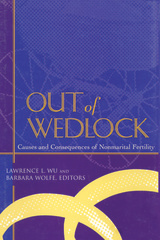
Out of Wedlock
Causes and Consequences of Nonmarital Fertility
Larry Wu
Russell Sage Foundation, 2001
Today, one third of all American babies are born to unmarried mothers—a startling statistic that has prompted national concern about the consequences for women, children, and society. Indeed, the debate about welfare and the overhaul of the federal welfare program for single mothers was partially motivated by the desire to reduce out of wedlock births. Although the proportion of births to unwed mothers has stopped climbing for the first time since the 1960s, it has not decreased, and recent trends are too complex to attribute solely to policy interventions. What are these trends and how do they differ across groups? Are they peculiar to the United States, or rooted in more widespread social forces? Do children of unmarried mothers face greater life challenges, and if so what can be done to help them? Out of Wedlock investigates these questions, marshalling sociologists, demographers, and economists to review the state of current research and to provide both empirical information and critical analyses. The conflicting data on nonmarital fertility give rise to a host of vexing theoretical, methodological, and empirical issues, some of which researchers are only beginning to address. Out of Wedlock breaks important new ground, bringing clarity to the data and examining policies that may benefit these particularly vulnerable children.
[more]
READERS
Browse our collection.
PUBLISHERS
See BiblioVault's publisher services.
STUDENT SERVICES
Files for college accessibility offices.
UChicago Accessibility Resources
home | accessibility | search | about | contact us
BiblioVault ® 2001 - 2024
The University of Chicago Press









